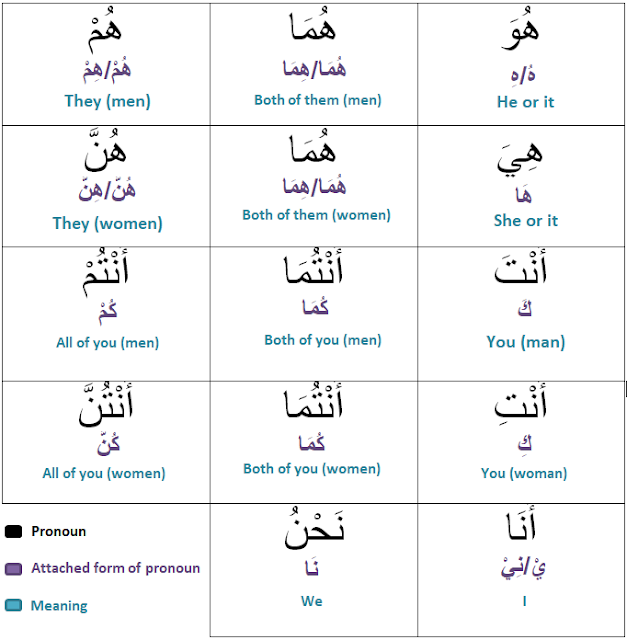Arabic Pronouns (dhameer)
Some
pronouns have two attached forms. We choose the attached form for a pronoun depending on the harakah (fili) on the last
letter of the word. For example if the word was كِتَابِ it
will be very difficult and sounds weird to say كِتَابِهُ
so the Arab says كِتَابِهِ and this would also mean ‘his
book’. So the second form of an attached pronoun is only used when there is a
kasra (ibifili) on the last letter.
The pronoun ‘ana’ is an exceptional case. We can change the
last harakah of the word to make the word end with an ‘ee’ sound. For example,
if the word is شَرَابُ (drink) we say شَرَابِيْ
in order to say my drink. If the word is بَيْتَ
(house) we say بَيْتِيْ in order to say my house.
Mental
exercise:
Attach the
pronouns to each word below and think of its meaning
كِتَابَ (book)
مَالُ (wealth)
رَبَّ (Master – usually occurs in
the Quran referring to Allah)
Note: All
the Arabic lessons I explain are inspired by my Quran and Arabic teacher Ustadh
Nouman Ali Khan. He has a website called Bayyinah TV where he has recorded the
tafseer of the entire Quran and has recorded a course called Arabic with Husna,
where he taught his daughter classical Arabic in a way that makes it easy to
understand the Quran. May Allah bless Ustadh Nouman for the work he has done in
inspiring me among many others around the world. Ameen!
*******************************************************************
ތިރީގައިވާ ތާވަލުން އެ ފެނިގެން ދަނީ ޢަރަބި ބަހުގެ 'ޟަމީރް'
ތަކެވެ. ޟަމީރަކީ އޭނަ، އެމީހުން، އަހަރެން، އަހަރުމެން ފަދަ ބަސްތަކެވެ. މި
ތާވަލުގައި ދަނބު ކުލައިން ފެންނަނީ ކޮންމެ ޟަމީރެއް އެހެން ބަހަކާއި ގުޅިގެން
އައުމުން އަންނާނެ ގޮތެވެ. ޟަމީރުތައް ވަކިން ވެސް އަދި އެހެން ބަހަކާއި ގުޅިގެން
ވެސް އައިސްދާނެއެވެ. މިސާލަކަށް هُو ގެ މާނައަކީ އޭނަ (ފިރިހެން) އެހެންނޫނީ އޭތިއެވެ. كِتَابُ (ފޮތް) ކަހަލަ ބަހަކާއި هُو ގުޅުވިދާނެއެވެ. ގުޅުވުމަށްޓަކައި އެ ޟަމީރު އެހެން
ބަހަކާއި ގުޅިގެން އައުމުން އޮންނާނެ ގޮތް ބަލާލަން ޖެހެއެވެ. هُو އެހެން ބަހަކާއި ގުޅުމުން އޮންނަނީ هُ ގެ ގޮތުގައެވެ. އެހެންކަމުން كِتَابُهُ އޭ އަހަރުމެންނަށް ބުނެވިދާނެއެވެ. އޭގެ މާނައަކަށް ވާނީ
އޭނަގެ (އެ ފިރިހެން މީހާގެ) ފޮތެވެ.
ބައެއް ޟަމީރުތައް އެހެން ބަސްތަކާއި ގުޅުމުން ދެގޮތަކަށް
އާދެއެވެ. އެ ދެގޮތުން ކުރެ އެއްގޮތް ޚިޔާރު ކުރަނީ ބަހުގައި އޮންނަ އެންމެ ފަހު
އަކުރުގެ ފިލިއަށް ބަލާފައެވެ. މިސާލަކަށް ބަހަކީ كِتَابِ ކަމަށްވާނަމަ كِتَابِهُ އޭ ކިޔަން ވަރަށް އުދަގޫވާނެއެވެ. އެހެންކަމުން ޢަރަބިން
ކިޔައި އުޅެނީ كِتَابِهِ އެވެ. މީގެ މާނައަކަށް ވެސް ވާނީ އޭނަގެ (އެ ފިރިހެން
މީހާގެ) ފޮތެވެ. އެހެންކަމުން ޟަމީރު ގުޅިގެން އަންނަ ގޮތްތަކުގެ ތެރެއިން ދެވަނަ
ގޮތް އަބަދުވެސް ބޭނުންކުރެވެނީ ބަހުގެ އެންމެ ފަހު އަކުރުގަ އިބިފިލި އޮންނަ
ނަމައެވެ.
ފަރިތަކުރުން:
ތިރީގައިވާ ކޮންމެ ބަހަކާއި ހުރިހާ ޟަމީރު ގުޅުވާށެވެ.
އަދި ގުޅުވާ ކޮންމެ ފަހަރަކު އޭގެ މާނައާއި މެދު ވިސްނާށެވެ.
كِتَابَ (ފޮތް)
مَالُ (މުދާ)
رَبَّ (ވެރިރަސްކަލާނގެ)
ނޯޓް: އަޅުގަނޑު މި ޕޯސްޓްތަކުން ކިޔައިދޭ ފިލާވަޅުތަކަކީ
އަޅުގަނޑުގެ ޤުރުއާނާއި ޢަރަބި މުދައްރިސްކަމަށްވާ އުސްތާޒް ނުޢުމާން ޢަލީ ޚާންގެ
ފިލާވަޅުތަކަށް ބިނާކޮށް ގެނެސްދޭ ފިލާވަޅުތަކެވެ. ބައްޔިނާ ޓީވީ ނަމަކަށް ކިޔާ
ސައިޓެއް އުސްތާޒް ހިންގާއިރު އެ ސައިޓުގައި މުޅި ޤުރުއާނުގެ ތަފްސީރާއި 'ޢަރަބިކް
ވިތް ހުސްނާ' ނަމަކަށް ކިޔާ ކޯހެއް އަޕްލޯޑްވެފައިވެއެވެ. ޢަރަބިކް ވިތް ޙުސްނާ
ގައި އުސްތާޒް ވަނީ އުސްތާޒްގެ ދަރިފުޅަށް ޤުރުއާނުގެ މާނަ ދެނެގަންނަން
ފަސޭހަވާނެ ފަދައަކުން ކުރީގެ ޢަރަބި ބަސް ކިޔަވައި ދެއްވާފައެވެ. އަޅުގަނޑަށާއި
ދުނިޔޭގެ އެތައް ބަޔަކަށް ބޮޑު ހިތްވަރެއް ލިބިގެން ދިޔަ އުސްތާޒްގެ
މަސައްކަތަށްޓަކައި މާތް ﷲ އުސްތާޒްއަށް ހެޔޮ ރަޙްމަތް ލައްވާށި! އާމީން!



Comments
Post a Comment